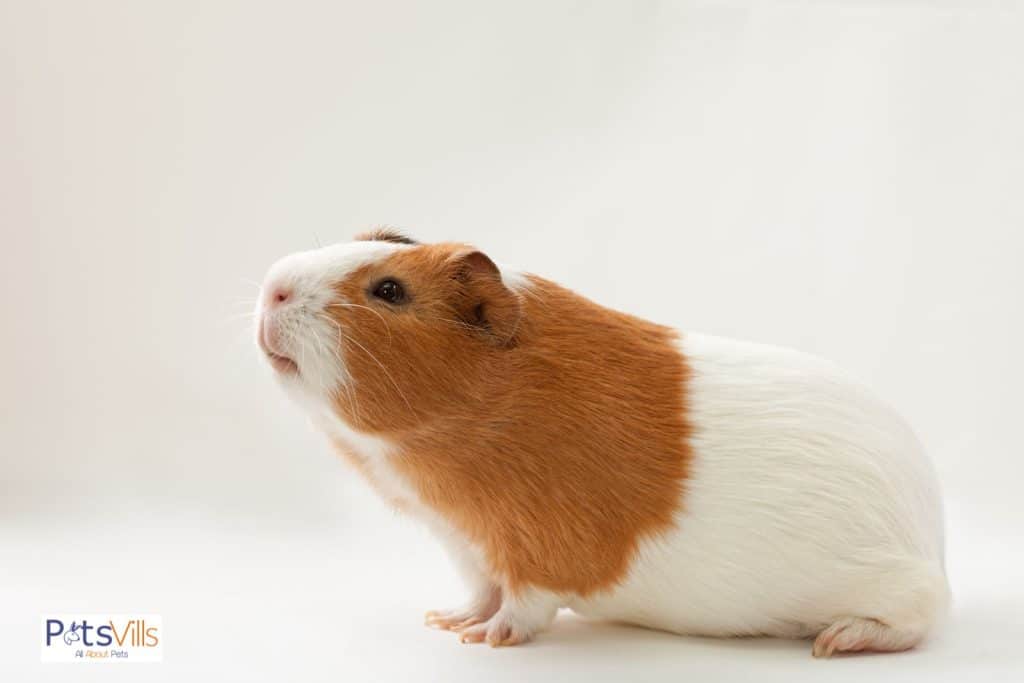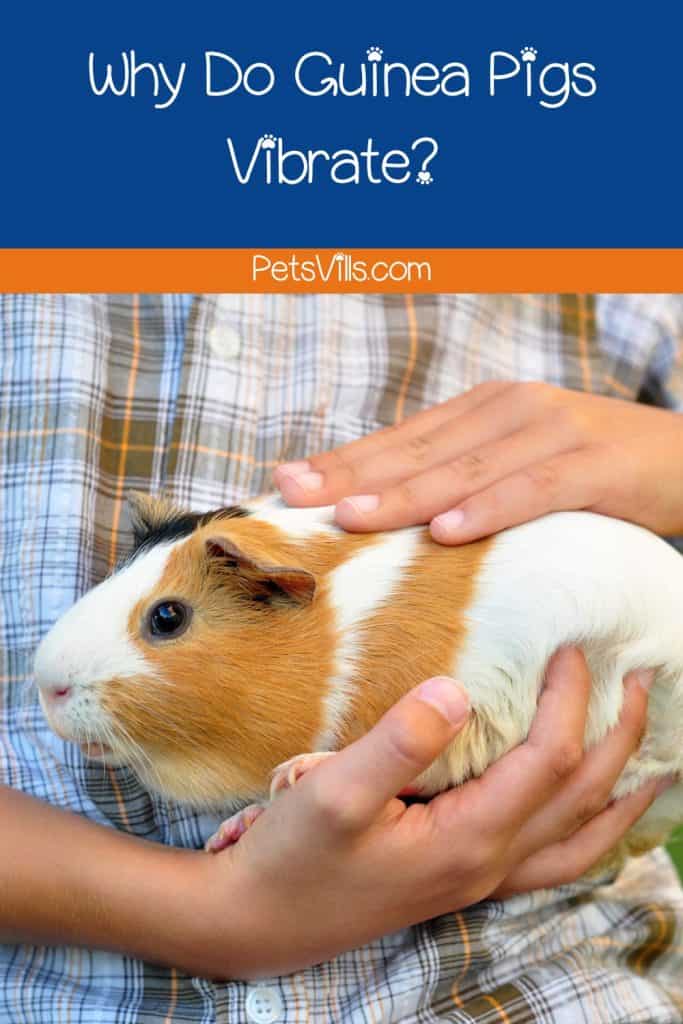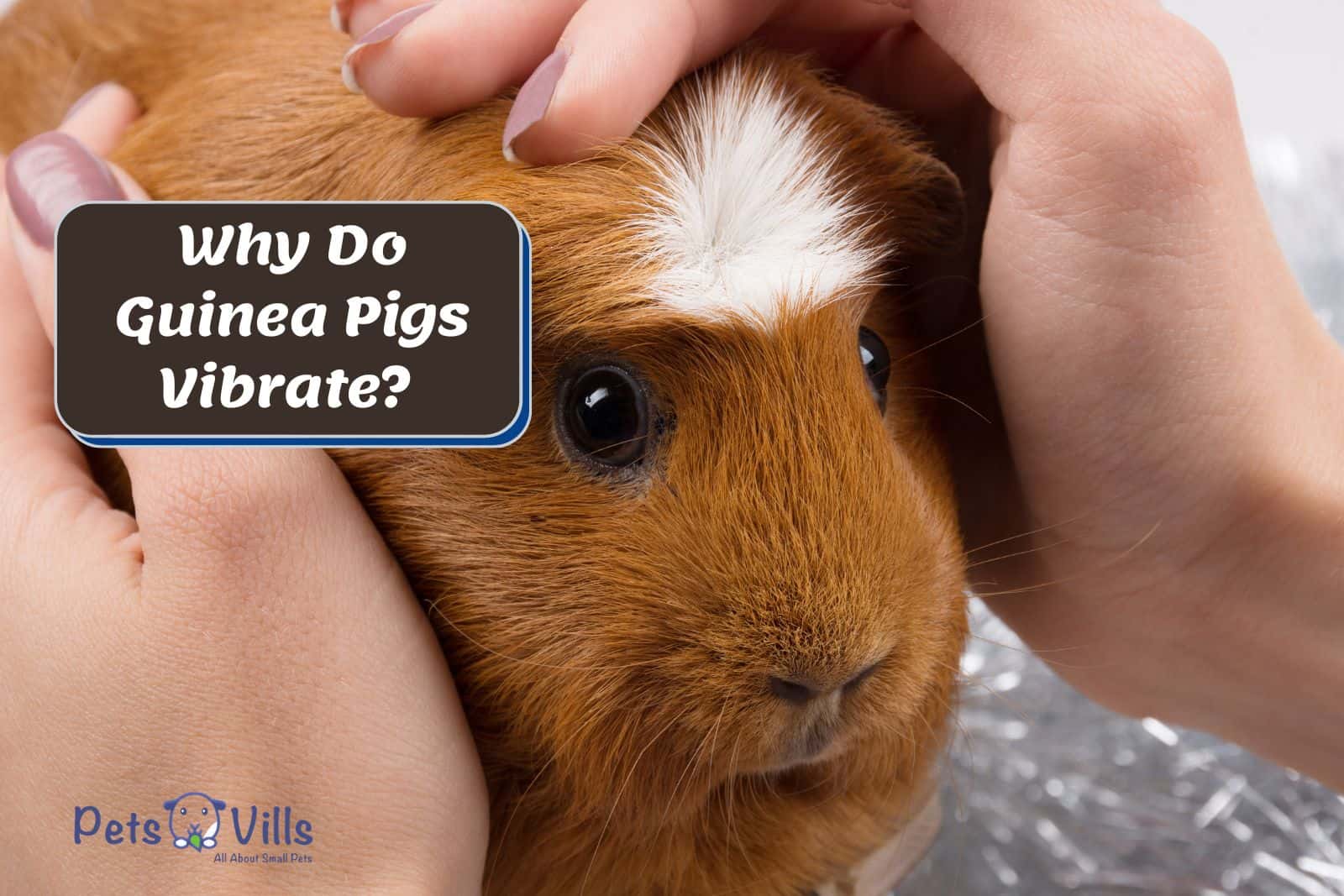Ever wonder, “Why do guinea pigs vibrate?”
As a seasoned guinea pig parent, it’s a question I’ve pondered many times over my years as my living room filled with the pitter-patter of their tiny feet.
I’ve observed these adorable rodents for years, and I can tell you that guinea pigs vibrate to communicate a range of emotions (1).
So, please pull up a chair, and let’s decode what your adorable guinea pig is trying to communicate!
Table of Contents
Key Takeaways
- These creatures use vibrations as one of their primary forms of communication. Each can express emotions and conditions, such as happiness, fear, excitement, cold, or even mating behavior.
- Observing the context of the vibration and any vocal sounds or other accompanying behaviors is crucial. They can help you understand what your cavy is trying to say.
- Responding appropriately to these vibrations helps ensure their comfort and well-being. Additionally, persistent or extreme vibrations, especially if accompanied by other signs of illness, should prompt a visit to the vet.
Why Do Guinea Pigs Vibrate? 5 Causes of Vibrations
Living with guinea pigs, I’ve spent countless hours studying their habits, particularly their delightful vibrations.
Here are my insights into the top five causes for these tremors, drawn from years of personal experiences with these charming critters.
#1 Happiness and Contentment
Ah, the delightful wiggle of a contented guinea pig! I’ve spent countless hours cuddled up with my guinea pigs, and this happy vibration has always been a favorite of mine.
Guinea pigs may hum a low, purring sound when pleased and content. You can also often expect it to come with a gentle, rhythmic vibration.
It’s their way of expressing satisfaction after a delicious treat or a pleasant petting session.
Check out this video!
#2 Fear and Stress
Life isn’t always hay and dandelions, even for our guinea pigs. I’ve noticed that when my little cavy buddies are startled or feeling anxious, they might vibrate or shudder.
Sometimes, these negative vibrations come with a higher pitch than their usual chirping sounds. It could be a response to strange noises or an unfamiliar situation.
According to the United States Department of Agriculture, other stressors include, “overcrowding or conflict in their social group, no access to enclosed spaces, other pets, and sudden changes to their daily routine” ( 2).
So once you become aware of these stressors, they become your cue to help these prey animals feel safe and secure again.
#3 Excitement or Anticipation
Who knew guinea pigs could get so giddy with excitement? I’ve often found that the prospect of a tasty snack or their favorite human can set off a bout of excited vibrations.
Watch for a rapid, fluttering motion, almost as if they are quivering with anticipation. Their adorable way of saying, “I can’t wait!”
#4 Feeling Cold
Even our fur-coated pals can feel the chill. On cooler days, I’ve seen my guinea pigs vibrate as they try to generate heat to reach a healthy body temperature.
It might look cute, but it is essential to ensure they’re cozy and warm. A quick snuggle or a blanket can make a difference in increasing their body heat.
#5 Mating Behavior
Lastly, there’s the world of guinea pig romance! As a guinea pig owner, I’ve seen my share of mating dances from these adorable, gentle creatures.
If your guinea pig is not neutered or spayed around a potential mate, it may vibrate distinctively, often accompanied by a unique series of sounds.
It’s nature’s way, but remember, being a responsible pet owner includes considering the implications of a potential guinea pig family!
Differentiating Between Types of Vibrations
You become an expert on their vibrations and body language when you share a home with guinea pigs. It’s a quirky world of communication that I’ve come to love over the years.
But it’s essential to know how to decipher them. As a result, let me share some tips on differentiating between the types of vibrations.

#1 Observe the Context of the Behavior
The first step is to consider the context. For instance, I’ve noticed that my cavy vibrates in a particular way when it’s mealtime versus when a stranger approaches their cage.
Remember, the situation often provides clues to what your pet might be feeling. It’s the only way to know what’s causing the vibration.
#2 Correlation with Vocal Sounds
Guinea pigs have a range of vocal sounds that often accompany their vibrations (3). For example, a gentle cavy purr with a mild vibration indicates contentment in my experience.
Meanwhile, a loud noise combined with trembling could mean they are scared or excited. Paying attention to their ‘soundtrack’ can provide valuable insights.
If you want a more in-depth discussion of cavy vocal sounds, look no further than this video.
It helped me significantly when I first tried to understand my piggies. I’m confident that it’ll also be a valuable tool for you.
#3 Look for Additional Behavioral Signs
Aside from vocal sounds, other behavioral signs will provide vital insight. So if my piggies are fearful, they may indicate it by vibrating sounds and hiding in the corner of their cage.
But if they’re vibrating while stretching out comfortably, I can tell it’s a sign of blissful relaxation. So these behaviors are excellent indicators of their emotional state.
How to Respond to Guinea Pig Vibrations
Understanding and responding appropriately to cavy vibrations is vital to your journey as a guinea pig parent. So let’s look at how to respond to each type correctly:
#1 Reward Positive Vibrations
When my cavies vibrate out of happiness or excitement, I respond with soft words and gentle petting. It’s a technique to help reinforce their positive emotions.
For instance, a timely treat or a tickle in their favorite spot often turns the moment into a memorable one, enhancing your bond. It’s a great way to deepen your relationship.
#2 Comfort Stressful or Fearful Vibrations
Dealing with fear or stress vibrations can be tricky. But after some trial and error, I’ve found a calm environment while gently reassuring them with my compelling voice.
Time and patience here are also essential to restore their sense of security. Trust me; the last thing you want to do is overwhelm an already stressed-out pet cavy.
#3 Provide Warmth When Cold Vibrations are Observed
Cold-induced vibrations call for immediate action. A warm, comfy environment can work wonders for your furry friend in these situations.
So I recommend adding extra bedding and a warm blanket to your guinea pig’s cage. It’s the best action when your fur baby isn’t too fond of the cold temperature.
#4 Meet Mating Vibrations With Safety and Comfort
Mating vibrations, primarily observed in male cavies, can seem quite dramatic. So when I first saw this, I took the time to understand this natural guinea pig behavior.
I learned that you want to ensure the environment is safe and comfortable. Doing so creates a less stressful space for pet guinea pigs during this vulnerable time.
When to Seek Veterinary Advice
As mentioned earlier, these vibrating noises sometimes require veterinary attention. Here’s when it’s wise to consult a professional.
#1 Persistent or Extreme Vibrating Behavior
If your guinea pig is persistently vibrating, it’s time to seek advice. I remember when mine vibrated more than usual, and a vet visit revealed it was due to a skin condition.
This experience proved that timely intervention is crucial in such cases. After all, I wouldn’t have had any idea how to help my piggy with my vet’s help.
#2 Vibrations Associated with Other Signs of Illness
Vibrations and other signs of illness, such as loss of appetite or lethargy, should not be ignored. It could indicate a severe underlying issue that needs immediate attention.
So don’t hesitate to schedule a vet visit whenever an additional symptom presents itself. It’s another reason why keeping a watchful eye on their overall health is essential.
#3 Schedule Regular Veterinary Care for Guinea Pigs
Regular veterinary check-ups are vital for our guinea pigs’ well-being. So I recommend scheduling visits every six months, even if everything seems fine.
It’ll give you peace of mind and ensure that any health issues are caught early. Otherwise, you might be caught off guard by a change in your cavy’s health.
FAQs
#1 Does a vibrating guinea pig indicate illness?
Vibrations don’t always indicate illness. But if other signs of illness accompany them or vibrations are persistent or extreme, it could suggest a health problem.
#2 Is a vibrating guinea pig cold?
A vibrating guinea pig could be a sign of them being cold. So it’s vital to ensure their habitat is warm and comfortable.
#3 What does it mean when a male guinea pig vibrates?
Male guinea pigs often vibrate around female guinea pigs as part of their mating behavior. However, they can also vibrate for the same reasons as female cavies.
Conclusion
So, why do guinea pigs vibrate? As I’ve discussed, there’s a symphony of emotions behind these cute quivers.
They could express joy, anticipation, fear, coldness, or even getting ready for romance! So it becomes essential to decipher them correctly.
After all, reacting correctly to these vibrations will ensure your cavy’s comfort and happiness. It’ll even deepen our bond with them, turning each one into a shared moment.
Let’s also remember the importance of regular vet visits to ensure their well-being. These visits could be the key to unlocking the reason by your cavy’s vibrations.
I hope you’ve found this dive into these vibrations enlightening and fun! After all, don’t we all wish to understand these lovable social animals better?

Resources
1. Guinea pig [Internet]. Smithsonian’s National Zoo. 2019. Available from: https://nationalzoo.si.edu/animals/guinea-pig
2. ANIMAL CARE AID Questions? Email us at CenterforAnimalWelfare@usda.gov [Internet]. Available from: https://www.aphis.usda.gov/animal_welfare/downloads/guinea-pig/acaid-guinea-pig-stress.pdf
3. Grimsley JMS, Shanbhag SJ, Palmer AR, Wallace MN. Processing of Communication Calls in Guinea Pig Auditory Cortex. Hausberger M, editor. PLoS ONE. 2012;7:e51646.

My name is Ben Roberts, and I absolutely love animals. So, naturally, I love writing about them too! As far as my animals, I have a Pit-bull, a Beagle-lab mix, a Chihuahua, and one old cat. Each one of them provides me with a new adventure every day. And the best part is they’re all best friends. Well, except the cat when he gets a little annoyed.
FIND HIM ON: FACEBOOK and TWITTER.
Read his latest ARTICLES
Learn more about Benhere


